When it comes to marketing, there is no doubt that content is king. But according to a recent Parse.ly study, 53% of organizations’ revenue goals are not tied to content. This is a major pitfall. If you don’t know how your content is impacting your bottom line, how can you know what’s worth your money and what’s not?
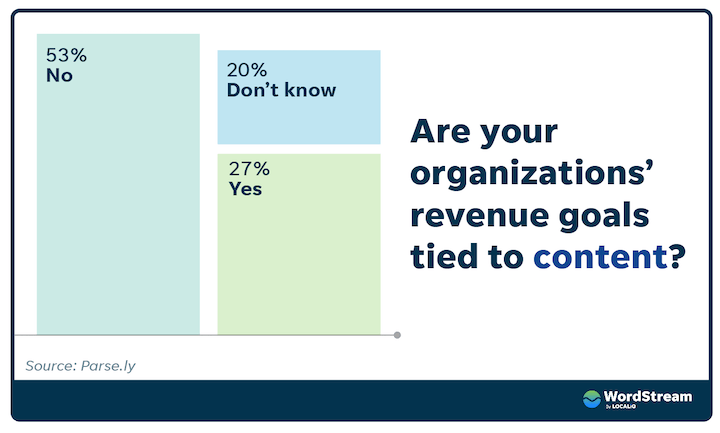
Although many believe that calculating the return on investment (ROI) of content marketing is a mystery that remains largely unsolved, this simply isn’t true. Your content efforts are highly attributable, but there are some mistakes to avoid.
So in this post, I’m going to provide everything you need to get the most accurate picture of your performance.
Table of contents
- What is content marketing ROI?
- The content marketing ROI formula
- Why it’s important
- Five tips to get it right
What is content marketing ROI?
Content marketing ROI is the revenue gained from content marketing as a percentage of the amount you spent on it.
Some might say there is more to it than calculating how much revenue it brought in, and I agree in part. But if we are being serious, all the metrics in marketing are aimed at the same central goal: driving revenue.
If a content marketing campaign drives traffic, engagement, and awareness, it’s still a failure if it doesn’t positively impact your bottom line.
Take this Google Data Studio dashboard, for example:
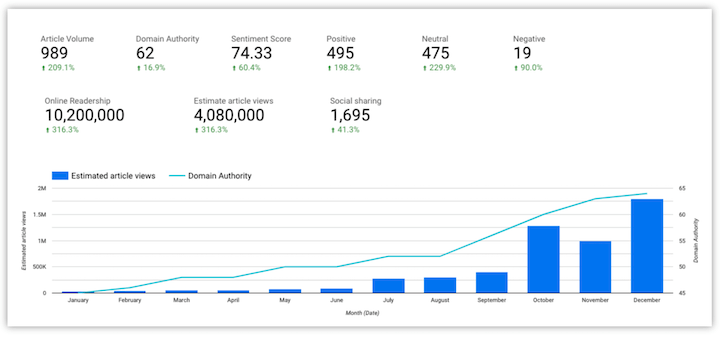
Data Studio is an invaluable marketing tool, and the metrics it shows are noticeable content marketing gains, but they don’t tell a complete story. You need to understand how much money and effort went into the campaign to see if your hard work has brought about any reward. Otherwise, you can’t know what’s worth reproducing and scaling.
The formula for calculating content marketing ROI
The formula for calculating content marketing ROI is: Revenue from content minus content marketing spend, divided by spend.
For example, let’s say your total investment in content marketing is $7,500 per month, and the amount of revenue you can attribute to content marketing is $10,000.
( ($10,000 – $7,500) /$7500 ) x 100 = 33.3%.
Your content marketing ROI is 33%. In other words, you’re getting about $1.33 back on every $1 you spend.

But let’s say you are spending $5,000 on content marketing each month and it’s bringing you 35 users worth $49 each. That’s a return of $1,175.
(($1,175 – $5,000) / $1,175) x 100 = -65.7%.
This means your content marketing ROI is -66%. You’re losing money.
Why calculate your content marketing ROI?
Having visibility into your return on investment is essential for any content marketing strategy. Let’s take a look at why:
1. Know where to put your investment
I recently spoke to the founder of a SaaS company who wanted to onboard me as a freelance writer. He knew that 80% of his customers, and therefore his revenue, was acquired through the company blog, so he wanted to increase his investment in content and SEO.
He came to this decision because he could tell how well content marketing had helped his company and that blogging was its most important channel.
And side note, he is not alone:
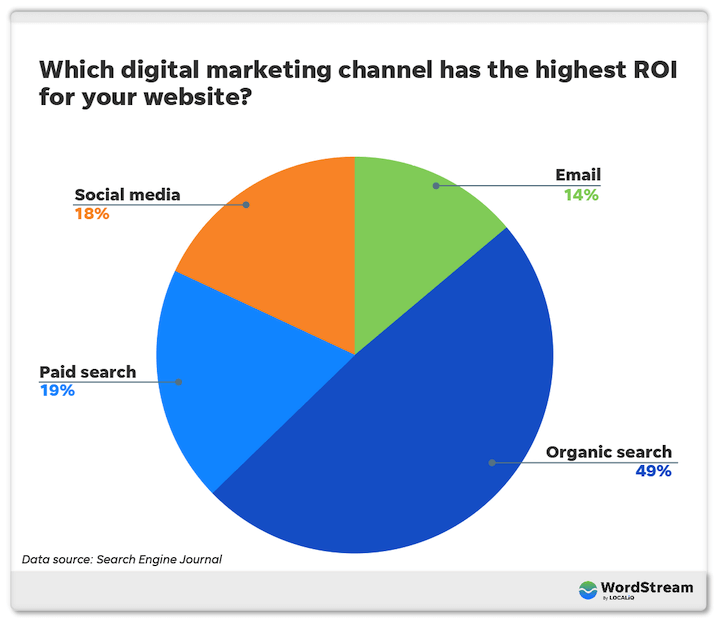
In other words, the ability to attribute revenue to a specific channel or content type will empower you to spend your money on what matters the most. After all, content marketing doesn’t work for everybody the same way. You may be finding success in blogging while your competitors may be killing it on social media.
When you dig into your data to get your content marketing ROI, you can understand:
- What content keeps your audience interested and converting
- Where you can cut down on spend
- Where you need to change your tactics or strategy
2. Secure buy-ins from stakeholders
Though content marketing has many benefits, it costs money. From writers’ salaries to tools and other related costs, there are enough expenses to go around.
When stakeholders gather to discuss business updates, it’s hard to convince them to let money keep flowing into content marketing without first proving to them that it’s bringing more money into the business.
Remember that traffic and sessions are important, but they alone can’t keep the business going. Only income can do that.
3. Attract customers to your services
If you’re trying to get more clients to your marketing agency, tying content to revenue will make it much easier to convince potential buyers to use your services.
When it comes to B2B marketing, the modern-day buyer knows better than to be impressed by mere traffic. “We increased revenue by 70% within x months” is more compelling than “We generated x pageviews in x months.”
I know this because I’ve sold traffic in the past and it’s a hard sell these days. While getting traffic to your website is essential, most B2B buyers want to know how content marketing fits into their bottom line metrics.
How to measure your content marketing ROI right
While there is a clear-cut formula for content marketing ROI, I see a lot people miss important considerations, so be sure to follow these five key tips so you can get the most accurate picture of your content marketing performance.
1. Have the right tracking in place
To get the most out of calculating your content marketing ROI, you need to be able to attribute returns to specific content types and channels. This requires you, first and foremost, to have the right tracking in place. This means that for all your offers you should be using tactics like:
- Landing pages and thank you pages specific to content and campaigns.
- Goals and events in Google Analytics.
- UTMs or other tracking parameters so you can analyze performance by source, medium, campaign, and content types.
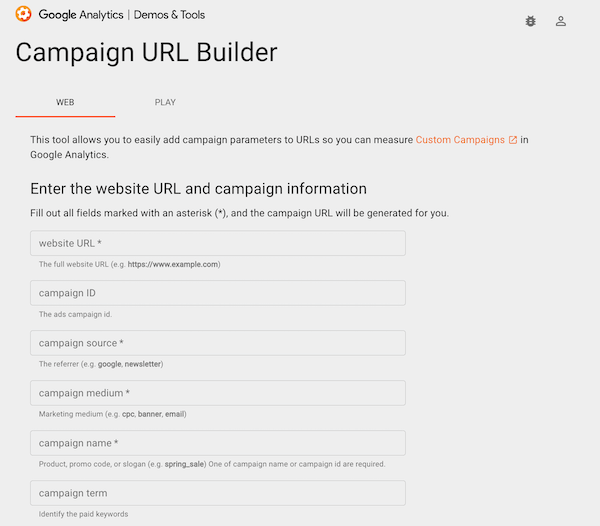
You can use Google’s UTM builder to create tracked links.
With these tactics, you can see not only which offers are getting the most conversions, but also which channels or even blog posts are driving the most traffic to those offers.
2. Define and value your conversions
Most businesses have a variety of marketing campaigns where a conversion is not a direct sale. You’ll want to assign a monetary value to that conversion anyway.
For example, if a gated content download brings you an average of 70 leads per month, and out of these leads, an average of 10 of them become paying customers, you can use that to assign a value to leads generated from that campaign, and even traffic to the landing page. We have some tips on how to determine conversion values here.
You’ll need to use your sales team and analytics data (such as through Google Analytics and Search Console), but ideally you’ll use a CRM and automation software, combined with tracked links and campaign-specific landing pages to be able to get the most accurate picture of your content performance.
Note that a CRM can also show you the different pieces of content a user interacted with during their buyer journey.
3. Know your metrics
In order to assign monetary values to your conversions and get content- and campaign-specific ROI, you need to know what metrics to track. This way you can see if your content marketing is on the right course and if anything needs optimizing or improvement. Here are key metrics to focus on, depending on your goals:
SEO metrics
You can find a full breakdown of SEO metrics here.
- Sessions
- Pageviews
- Impressions
- Clicks
- Organic click-through rate
- Backlinks
- Impressions
- Bounce rate
- Sessions
- Click-through rate
- Keyword rankings
- Domain authority
- Pages per visit
- Organic conversion
social media metrics
- Reach
- Impressions
- Audience growth rate
- Amplification rate
- Engagement rate
- Click-through rate
- Conversion rate
PPC metrics
You can find a full guide to PPC metrics here.
- Cost per click
- Cost per thousand impressions (CPM)
- Cost per lead
- Click-through rate
- Conversion rate
- View-through conversions
Email metrics
- Opens
- Clicks
- Open rate
- Click-through rate
- Conversion rate
- Bounce rate
- Subscribers
- Unsubscribes
4. Gather ALL of your costs
This sounds obvious, but it is where most content marketers get it wrong. There are lots of content marketing tools you use that you need to take into account. Consider:
In addition to the payments that you make to freelance writers. It includes the cost of:
- Keyword research tools
- AI copywriting tools
- Editing and uploading the content into your CMS
- Designing the images
Costs of content distribution and optimization
Content distribution channels include paid, earned, and owned. Many of them are free, like Facebook, Reddit, and Quora, but you might also be using:
- Paid campaigns
- Social media tools like Hootsuite and Buffer
- Social media content generators
- Social listening tools like Mention
- Social media manager or community manager
- Analytics tools (aside from Google Analytics, which is free)
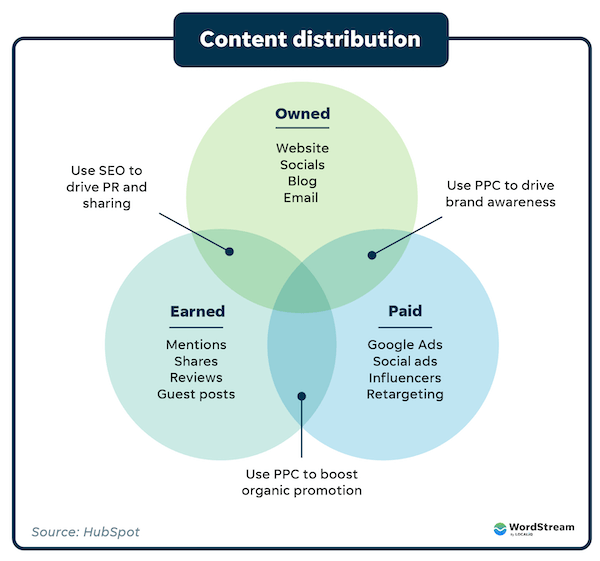
You can make rough estimates with your tools. For example, let’s say you pay $100/month for a content optimization tool and you publish 10 posts per month. You can say each article costs you $10 to optimize.
5. Remember that it’s not going to be perfect
Let’s say a potential buyer comes across one of your blog posts for the first time while seeking a solution to a particular problem. They note that your brand is a potential solution but aren’t immediately ready to buy it. Two weeks later, they look you up on Google and read more about you before eventually landing on your website again, where they sign up for a free trial. The channel they came in from will be attributed with the conversion, but what about the blog post that made them aware of your business in the first place?
If you have a content marketing funnel, those top-of-funnel offers are going to be harder to track. All that is to say that you won’t be able to capture every aspect of your content marketing ROI in detail, but you can get pretty close with the tips I’ve provided. Just be aware that cases of underreporting are more likely than overreporting.
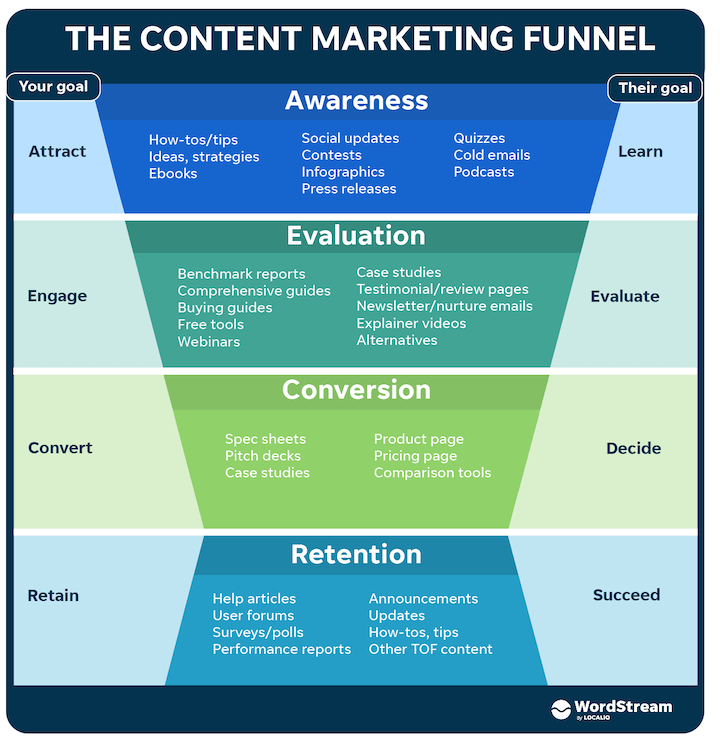
Start calculating your content marketing ROI today
While calculating the ROI of content marketing isn’t rocket science, it can be easy to miss important details and create unnecessary confusion for yourself. But with the tips I’ve provided, you should be able to get a pretty close calculation so you can understand and improve your strategy.
To recap:
- The content marketing ROI formula is (return – cost / cost) x 100
- Knowing your content marketing ROI is essential for knowing how much of your budget to invest in content, and to which channels.
- To get the most accurate measurement, you need to have tracking in place, conversion values determined, and the right metrics in mind.
About the author
Ali Faagba is a content strategist and writer for SaaS and B2B brands. He loves product-led strategy and tests his SEO assumptions at Content Marketing Profit. Bylines include Entrepreneur, Zapier, CoSchedule, and more.
The post How to Measure Content Marketing ROI Right: Metrics, Math & Mistakes to Avoid appeared first on WordStream.




Recent Comments